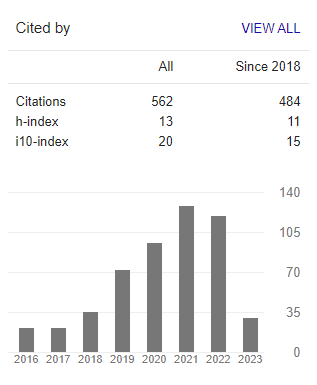PESONA DAN KHARISMA USTADZ DALAM IMAJINASI POPULER DI INDONESIA
Abstract
The development of globalization and the present information age has influenced many relationships in the world of life, including the life of religiosity, especially Islam. Relation between religion and culture mainly through the development of popular culture in the era of globalization and information is characterized by various problems, dilemmas, and contradictions. In the millennium era in Indonesia the power of religion and the power of popular culture in the larger cultural context has led to various contradictions and paradoxes in religious life. The development of popular culture has had a profound effect on how religion is now understood and ritualized.
To cite this article (7th APA style):
Chaniago, R. H. (2018). Pesona dan Kharisma Ustadz dalam Imajinasi Populer di Indonesia [Ustadz's Enchantment and Charisma by Popular Imagination in Indonesia]. Journal Communication Spectrum, 8(1), 1-14. http://dx.doi.org/10.36782/ jcs.v8i1.1809Keywords
References
Adorno, T. W. (1991). The Culture Industry. Routledge.
Adorno, T. W. (1941). On Popular Music. Dlm. Storey, J. 2006. Cultural Theory and Popular Culture A Reader 3rd Edition (hal. 73-84). Routledge
Barker, C. (2003). Cultural Studies: Theory and Practice 2nd Edition. Sage Publications.
Baudrillard, J. (2000). Jean Baudrillard Routledge Critical Thinkers Essential Guides for Literary Studies. Routledge.
Benjamin, W. (1968). The Work of Art in The Age of Mechanical Reproduction. Dalam Arendt, H. (ed), Illuminations. Fontana.
Berger, P. L., & Luckmann, T. (1966). The Social Construction of Reality: A Treatise in the Sociological of Knowledge. Penguin Books.
Bungin, B. (2008). Konstruksi Sosial Media Massa. Kencana.
Burton, G. (2008). Media dan Budaya Populer. Jalasutra.
Chaney, D. (1996). Lifestyles (Key Ideas). Routledge.
Coutas, P. (2008). Fame, fortune, fantasi Indonesian Idol and the new celebrity. Dalam Heryanto, A. (ed), Popular Culture in Indonesia Fluid Identities in Post-Authoritarian Politics (hal. 111-129). Jalasutra
Dahlan, M. A. (2012). The New Media and Islam: Communication Characteristics and Dynamics. Journal Communication Spectrum, 2(1), 1-12
Eriyanto (2002). Analisis Framing Konstruksi, Ideologi, dan Politik Media. LKiS.
Fuziah K. H. B. (2018). Akademi Fantasia: Dimensi baru budaya popular di Malaysia. Dlm. Mus Chairil Samani., Badrul Redzuan Abu Hassan. & Mat Pauzi
Abd. R. (2004). Penyertaan Dalam Komunikasi Hak, Bentuk dan Dasar (hal. 197-206).
Kaplan, E. (2006). Feminist Critism and Television. Dlm. Barker, C. (ed), Cultural Studies: Teoridan Praktik. Kreasi Wacana.
Piliang, Y.A. (2011). Bayang-Bayang Tuhan “Agama Dan Imajinasi”. Mizan.
Setiowati, E. (2008). Imperialisme Budaya Dan Pembentukan Identitas: Kajian Terhadap Fanatisme Remaja Pada Budaya Pop Jepang. Jurnal Thesis Penelitian Ilmu Komunikasi, 7(3)
Uprini, C., Sujianto, U. & Indrawati, T. (2002). Komunikasi Kebidanan. Penerbit Buku Kedokteran EGC.
Refbacks
- There are currently no refbacks.

This work is licensed under a Creative Commons Attribution 3.0 License.
Indexed by:
Archived in:
Listed in:
INTERNATIONAL ASSOCIATION FOR MEDIA AND COMMUNICATION RESEARCH

















